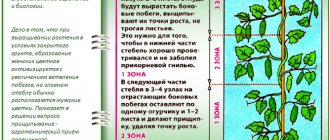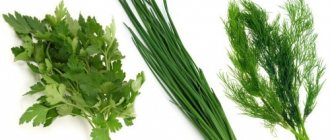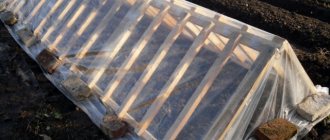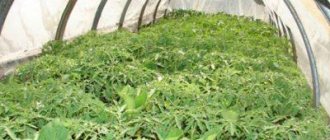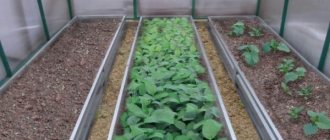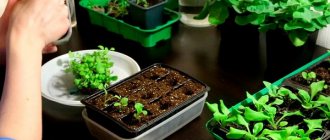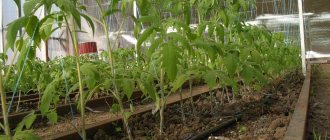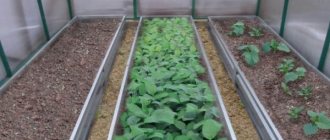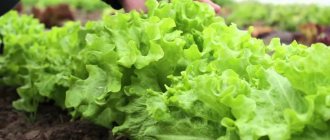To grow a good harvest of cucumbers in a greenhouse, you need to remember that greenhouse conditions do not protect cucumbers from pests and diseases, but only create a favorable environment for cucumber seedlings to grow in the form of sunlight and optimal air temperature inside the greenhouse.
However, cucumbers in a greenhouse are susceptible to diseases and threats from pests. Among the most common diseases in greenhouse conditions are fungal, bacterial, and viral infections of cucumbers, the causes of which can be violations of the optimal conditions for growing vegetables in a greenhouse.
Soil preparation
Already at the construction stage of the greenhouse, it is worth determining a place for planting cucumbers. The site should be sunny and away from tall trees and buildings that can create shadows.
The inside of the greenhouse for growing cucumbers must be equipped with plant supports
The material for the greenhouse should be chosen that is durable, has high light transmittance and has high thermal insulation qualities, especially if early sowing is planned. Polycarbonate greenhouses have these properties. You can build it from glass or cover the frame with film. However, the film quickly deteriorates and the greenhouse will need to be covered next season.
Soil preparation consists of the following stages:
- dig up the ground. At the same time, it is worth removing all the roots of weeds;
- if the acidity of the soil is high, you can add chalk or quicklime to the soil during digging;
- add a solution of copper sulfate to the soil. This will disinfect it from many pathogens. If there is a possibility of fungal spores remaining in the soil, you can remove the upper part of the soil in which they are located (up to 7 cm);
- lay the substrate prepared in advance. The following composition is considered optimal: peat, humus, fertile soil, sawdust. Instead of sawdust, you can add manure, but you should not add other fertilizers to the soil.
Important! Adding wood ash will help reduce the risk of disease. It can be added systematically, at any stage of preparation.
You can tighten the wire in advance or prepare trellises; bushes will be tied to them as they grow.
Mineral fertilizers
Various types of mineral fertilizers are used to feed cucumbers. The main criterion for their selection is the presence or absence of NO3 and Cl. Some sources claim that preparations containing these substances should not be used for cucumbers.
The most famous mineral fertilizers used for cucumber bushes:
- superphosphate;
- nitrophoska;
- urea.
Superphosphate is used to feed bushes with phosphorus. It can be applied either to the soil in dry form or used to prepare a solution (20 g/10 l). It is recommended to add it to the soil when digging in the fall.
Nitrophoska is a complex fertilizer that contains 3 main vital components - nitrogen, phosphorus, potassium, as well as microelements.
In dry form, it is brought underground to a depth of 8 cm. To prepare the solution, 40 g of granules are dissolved in a bucket of water. Each plant requires 300-500 ml of liquid.
Urea (carbamide) is a mineral fertilizer with a large amount of nitrogen. It can be applied or watered at the root, or used for leaf nutrition. It is recommended to embed it in the ground only in spring (5–10 g per 1 m2). However, it works better in the form of a solution - 20–30 g/10 l at the root, 50 g/10 l at the leaf.
Transplanting
You can prepare the seedlings yourself by growing them at home or planting cucumbers in a greenhouse with seeds. Many experts agree that planting seedlings is more effective. Such a seedling will be hardened and will grow faster.
Only strong and hardened seedlings can be planted in a greenhouse.
Planting begins in May, when the earth has warmed up. To get an early harvest, they are planted in April, but two weeks before that the beds are covered with film. When forming ridges, it is worth assessing the future size of the bush. It is recommended to make 1-2 rows if the width of the bed is 1 m. In each row, make deep holes every 30-40 cm, which need to be watered abundantly. Planting at a smaller distance may limit light access to some bushes, and the seedlings will interfere with each other as they grow.
If your seedlings grew in peat pots, plant them with them
Planting is carried out directly in peat pots. Otherwise, the root may be damaged, causing the bush to develop slowly. Planting cucumbers requires some attention. In particular, the root collar should not be allowed to touch the soil. This will provoke diseases caused by microorganisms that fall on the neck during watering.
In what cases can cucumbers be treated with folk remedies?
With spring comes concerns about the future harvest. A variety of vegetables grow in every garden.
Due to its easy care, abundant harvests and universal use, cucumber is loved by all gardeners. However, this unpretentious vegetable, like others, needs additional attention and protection from possible diseases.
In parallel with a variety of chemical agents, summer residents actively use folk remedies that help them fight parasites, as well as pathogenic microorganisms that cause a variety of diseases in cucumbers.
Natural ingredients that are harmless to humans and the soil are often used as folk remedies to destroy cucumber diseases and their pathogens. You can treat the bed with them both for preventive purposes and directly for treatment.
Traditional remedies exhibit a great therapeutic effect in the early stages of the disease, when the following signs appear:
- Yellowing of leaves.
- Rotting leaves and greens.
- Development of crooked cucumbers.
- Dying of part of the vine.
- Falling of the ovaries.
Ignoring such signs increases the likelihood of losing the harvest. Timely processing of the crop not only has healing properties, but also helps to increase fruiting.
Formation of bushes
Temperature conditions are very important for the proper formation of seedlings. Planting is carried out at daytime levels up to +20°C and at night +17-18°C. After fruiting begins, the temperature level should be higher than a couple of degrees. Sudden changes should be avoided, otherwise the fruits will taste bitter.
Important! Not only temperature conditions, but also any stress causes a defensive reaction in cucumbers, which is why they acquire a bitter taste. Stress is caused by lack of moisture, uneven application of mineral fertilizers, etc.
As the bush grows, you need to tie the cucumbers to the trellises with twine or soft rope. It is better to do this at each internode.
Tie the bushes to supports so that the fruits do not lie on the ground
The bush should be formed according to the following rules:
- The first lateral shoots need to be removed.
- Shoots grow from the axils; it is better to pinch them off above the first leaf.
- The upper shoots can be pinched under the second leaf.
- Pinch off the top after the bush has grown above the trellis.
Many experts recommend picking the flowers of the first ovary. It is believed that these cucumbers ripen slowly, so you should not waste the nutrients. It is better to direct them to faster formation of the bush.
How to understand and what to do if too much fertilizer has been applied?
Plants suffer not only from a lack of nutrients, but also from their excess. Sometimes gardeners get so carried away with applying fertilizers that they destroy plants while they are still standing. Large amounts of chemical fertilizers are especially dangerous.
If too much fertilizer is applied, the plant is watered with plenty of water. If the bush is still small, then transplant it to another place.
When growing cucumbers in a greenhouse, the feeding procedure is especially necessary, since it is not possible to completely replace the soil every year. Timely application of the necessary fertilizing can save you from many troubles and not only significantly increase productivity, but also improve the taste and appearance of the fruit.
0
0
Copy link
Watering
Caring for cucumbers includes abundant and systematic watering. There should be no lack of moisture. Abundant but infrequent watering will also have a bad effect on fruit formation. This can cause some diseases and also leads to deformation of the cucumber. The optimal consumption is 7-8 liters per 1 sq.m. It is recommended to water in the morning, and the water should be warm. The frequency of the procedure is: once every 3 days after planting, every other day - during active growth, once a day - in hot weather.
Water the plants so that moisture does not get on the leaves
Since cucumbers love high humidity, it is allowed to spray the bushes with water by arranging automatic watering in the greenhouse. On hot days, it is worth sprinkling once or twice a week. Do not water cucumbers at the roots. Excessive exposure of the roots or moisture on the stem can provoke certain diseases. It is better to make grooves between the rows and holes and pour water into them.
Important! Drooping or wilted leaves indicate a lack of moisture.
Proper care includes loosening, which is done after watering. During this procedure, it is worth covering the root collar with soil if it opens. When the bushes grow, it will become simply impossible to loosen the soil.
Green speckled mosaic
The causative agents of green mosaic are viruses that most often attack crops in protected soil conditions, and are less likely to become active in open areas. The first signs of the disease can be noticed a month after planting the seedlings in a permanent place, and even earlier.
If the air temperature rises sharply, bright green spots appear on the leaves, and the number of female inflorescences is greatly reduced, which is fraught with large yield losses. And the surviving fruits themselves develop very slowly, become deformed and become covered with a mosaic coloring. Their taste also suffers.
As soon as the first symptoms of mosaic appear, the plants should be treated with a solution of skim milk, and it is also useful to lower the stems to increase the root system.
Green mosaic should be differentiated from white. The latter is characterized by zonal chloroticity, and later the disease causes bending of the leaves and their wrinkling. Dark green areas affected by the virus are combined with light green areas. The plant stops developing and growing normally, the number of flower ovaries decreases, and the internodes become shorter.
Top dressing
Feeding is an integral part of caring for cucumbers, but it is important to follow the basic rules to ensure a high-quality harvest. In particular, you should not fertilize the bushes in the first vegetative phase. They require few nutrients. It is better to start applying fertilizers from the moment the first flowers and ovaries appear.
The plant needs feeding throughout the growing season.
Fertilizing with organic matter (bird droppings, mullein) is carried out with infused and fermented substrate. To do this, pour 150 g of manure into a bucket of water and let it brew for 2 days. Each seedling will need about 0.5 liters. After the procedure, you need to water the cucumbers. You can add urea or superphosphate to the fertilizer. This is suitable for fertilizing during the flowering period.
Organic fertilizers must be alternated with mineral ones. Each growing season requires certain substances:
- active growth – nitrogen substances;
- flowering - phosphorus;
- fruiting - nitrogen-potassium.
Important! Foliar feeding is carried out rarely, usually when the temperature regime is violated. When spraying, you need to pay attention to the lower leaves, which absorb the solution better.
Apply organic fertilizers little by little to avoid overfeeding the plants.
You should not apply fertilizer more than 5 times per season, otherwise even proper care will not allow you to reap a good harvest. It is necessary to pay attention to the development of the bush and fruits in order to determine which fertilizers are best to apply:
- The bushes are actively developing, but flowers are not formed - there is an excess of organic fertilizers. You need to add minerals.
- The fruits curl, forming “hooks” - potassium deficiency.
- Cucumbers are thick at the stem, sharp at the tip - there is not enough nitrogen.
Gray rot
The disease spreads by contact and air during harvesting or when caring for bushes.
Signs
Gray rot is manifested by the spread of brown spots on cucumber leaves. With high humidity, mold appears on cucumbers with fluffy gray spores, which are carried to other bushes by drafts.
Causes
The disease appears and begins to actively develop only under certain conditions. The most suitable environment for the appearance of gray mold is low temperature and waterlogging. Therefore, it is recommended to regularly monitor the humidity and temperature in the greenhouse.
Prevention
To prevent the appearance of gray rot and protect cucumbers from diseases, you need to:
- properly care for the bushes and regularly spray them with special protective preparations;
- plant cucumbers at a distance of at least 80 cm from each other;
- be sure to spray the beds and greenhouse after harvesting;
- observe crop rotation.
Treatment
When the first symptoms of gray rot appear, it is recommended to stop watering the plants for 2-5 days. You should also ventilate the greenhouse and get rid of all affected leaves. To treat cucumber bushes, you can use ash or copper-chalk powder.
Cucumber diseases
Diseases on cucumbers develop due to external factors, most often associated with improper care. Copperhead (Antacnose) is the most common disease, characterized by round yellowish-brown spots on the leaves. Over time, the stains become dry and crumble. If left untreated, the disease will spread to the fetus. It will become covered with ulcers with a pink coating, which will later turn black. It is necessary to regularly spray the bushes with a solution of Bordeaux mixture with copper.
Cucumber disease - anthracnose
White rot appears as a dense white growth on stems, leaves and fruits. The growth gradually becomes limp and turns into mucus. The development of the disease is provoked by waterlogging. The affected areas of the bush need to be cut off and removed, since they cannot be cured. The cut areas should be sprinkled with vitriol or lime. The fungus remains in the soil, so it needs to be disinfected and the top layer replaced.
Gray rot occurs more often on fruits. It is expressed in the form of wet spots of a brown tint, on which a gray coating with black inclusions forms. Development is provoked by sudden changes in temperature, cold water or excess moisture, and lack of nitrogen in the soil. You need to fight it the same way as with white rot.
Powdery mildew on cucumber leaves
The following diseases of cucumbers are no less common:
- powdery mildew. A white coating appears on the leaves, and over time it spreads to the bush. The leaves wither and dry out. The disease is caused by changes in temperature or waterlogging of the soil. Affected leaves should be removed. You can spray the bushes with mullein infusion or colloidal sulfur with laundry soap;
- downy mildew. It is characterized by brown spots on the outside of the leaves and a grayish-purple coating on the inside. The disease spreads very quickly: the leaves curl, dry out, and fall off. The bushes should be sprayed with phytosporin, Bordeaux mixture, copper-soap or kefir-iodine solution. The soil can be sprinkled with ash. The disease is also transmitted by seeds, so they need to be treated with potassium permanganate;
Plant affected by root rot
- root rot. First, small yellow spots appear on the leaves, the lower leaves dry out and subsequently the entire lash dies due to the death of the root. Overwatering causes disease. You need to spray the bushes with previkur;
- bacteriosis Brown ulcers appear on the leaves and fruits, which turn into holes. You need to spray the bushes with Bordeaux mixture.
Important! To normalize humidity, the greenhouse should be ventilated periodically. At the end of the season, treat the greenhouse with chemicals.
Preventive measures and care will not help rid cucumbers of pests. The most common of them are aphids and whiteflies. The first must be combated with the help of an infusion of red pepper, which is mixed with tobacco dust, tree resin and laundry soap. Spraying should be carried out regularly, and the paths also need to be treated. You can fight whiteflies with the drug Actofite, and to block its access to the greenhouse, you should hang nets on the windows.
Anthracnose or rust
It is caused by ascomycete fungi, which are responsible for the appearance of dark brown spots on the leaves. As the disease develops, these spots merge into one and cause the leaves to fall and then the death of the plant. The entire above-ground part is at the mercy of fungi, and even if the fruits set, they rot.
Owners of their own greenhouses in temperate climates are familiar with it firsthand. Signs of the disease appear during the wet season, when it rains continuously amid stifling heat.
It is customary to combat anthracnose with the help of Bordeaux mixture
It is very important to destroy all plant remains after harvesting, and cutting out and burning the affected parts is also used as a preventive measure.
